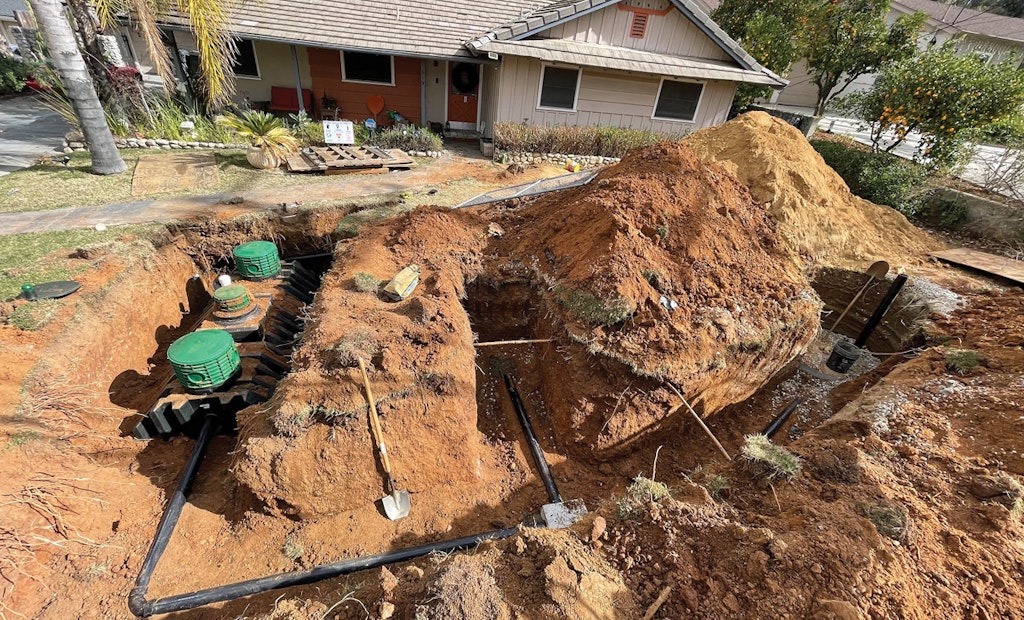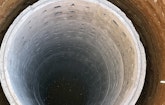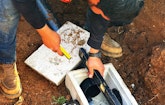
After flowing through the existing septic tank (not pictured), wastewater at the Redlands lot moves through a Jet aerobic unit and then to a pair of seepage pits. (Photos courtesy American Septic Services Inc.)
Interested in Systems/ATUs?
Get Systems/ATUs articles, news and videos right in your inbox! Sign up now.
Systems/ATUs + Get AlertsThe city of Redlands is 63 miles east of Los Angeles, still part of urban Southern California but not entirely served by sewer.
“Because of the topography, there are a lot of little canyons. They couldn’t have gravity-flow sewer for the whole city, so a large percentage of the homes are on septic systems,” says Zekai Nazikoglu, president of American Septic Services Inc. in Redlands. “A lot of people don’t know, when they buy expensive houses, that they’re on septic.”
His onsite project in Redlands involved the addition of a 900-square-foot house at the back of a 0.37-acre lot. Typically these are called mother-in-law houses, a small dwelling for an aging relative, but in this case it was for a mother whose daughter lived in the main house of 1,586 square feet. The property had been served by a conventional septic system.
When the project began, a state rule came into play, Nazikoglu says. In California, an advanced treatment unit is required for any home addition or a second dwelling if the lot is less than a half-acre. The old system was under a grandfather clause, but now it had to go, and both the main house and the small house had to be connected to a new ATU.
The system
Effluent leaves both buildings in 4-inch-diameter ABS pipe and joins a main line of the same size. Both PVC and ABS are allowed by California, Nazikoglu says, and while both are good, he prefers ABS because it is black. Anyone working on the system in future will immediately know the pipe carries wastewater.
The 4-inch collection pipe runs 452 feet from the back of the lot, where the mother’s house is, to the old 1,000-gallon concrete septic tank in the front yard. The two-compartment concrete tank is now used for settling and pretreatment. Wastewater flows next to a 750-gallon plastic tank holding the aerobic treatment package from Jet Inc., which includes a UV system.
Effluent then flows about 8 feet to a distribution box where it is split between two pipes that carry it to a pair of seepage pits. Each pit is 5 feet in diameter and 24 feet deep, and has a perforated concrete liner. Pro-Cast Products, in Highland, California, made the liners and lids.
A Jet panel controls the system.
For the job, Nazikoglu’s crew used a 2009 Ditch Witch trencher and a 2012 CASE 590 Turbo backhoe.
“The back of the property wasn’t big enough to use large equipment,” Nazikoglu says. “I used the trencher to set the width and depth, and then we used manpower, a jackhammer, and hand digging for about 100 feet.”
The crew also used an Earth Drill rig to bore a seepage pit hole. When the drill bit is full of dirt, a worker on the ground pulls a trip line to empty the soil.
“A lot of people were telling me, ‘Doc, you are a scientist, why don’t you have an automatic trip?’” he says. (Nazikoglu holds a doctorate in geology and geophysics and taught at Chapman University in Irvine, California.) “I don’t want an automatic trip because I want a second person there. Safety wise, if something happens, the other person can call me.”
Challenges
Permitting wasn’t easy, and the COVID-19 pandemic made it worse. Permits are issued under a local area management program required by the state water control boards. But when they first applied for this permit, Nazikoglu says, the city of Redlands didn’t have its management program in place yet. So the permit application first had to go to state government. Once that approval was given, the application was submitted to the city.
“I waited about four months to get the OK for this system,” he says. “When COVID hit, you couldn’t go talk person to person. You are emailing. When you are emailing, you don’t know how many emails that person got.”
Permit problems aside, he says, construction took a week.
Pipes from the main house could easily provide gravity flow. It was different for the mother-in-law house, which was at the back of the lot. “I had to advise the contractor, don’t bury the pipes too deep,” Nazikoglu says.
He specified no deeper than 18 inches. The back half of the lot was flat. From the middle to the front, where the system was, the lot sloped 1% to 2%. This was enough to provide gravity flow.
In the seepage pit holes, soil was organic matter and some silty sand in the top 3 feet, then sandy with quarter-inch-diameter gravel below. Water table height was not an issue.
Seepage pit
Concrete seepage liners were in sections 5 feet in diameter and 3 feet high. Holes consume about 48% of the liner surface, and the sections have tongue-and-groove edges. The hole bottoms were finished by flattening the dirt, and the bottom must be perfectly flat in order to ensure the liners are vertical, he says. In some cases it’s necessary to bed liners with gravel.
Seepage pits are the designer’s choice, Nazikoglu says, and they have advantages. First, they don’t require the horizontal space of a drainfield, and regulations require a 100% buffer for future expansion, which means losing some or all of a backyard, he says. Second, they can store water and be pumped if a system fails. Once a drainfield is saturated, it’s done, he adds.
Influent contribution from the second dwelling on the property was calculated at 75 gpd. That would suffice for a one-bedroom dwelling with a resident up to 40 years old, he says. For older people, water usage tends to drop to about 60 gpd per person. But he allowed for a bit more capacity than is strictly required.
Watch the sprinklers
There was a three-week delay in getting components from Jet due to supply-chain problems that accompanied the pandemic, he says.
Overhead wires along the street didn’t pose a problem for the crew running the earth drill rig, Nazikoglu says. “Our biggest problem was there were a lot of water sprinkler lines. We had to cut and fix those. That takes time.”
One reason why the job went as quickly as it did was Nazikoglu’s change in the design. Originally the design called for a filter system and leach lines, all in the backyard. That would have required a lot of hand digging, he says. In the revised design he reused a seepage pit from the old system, and there was no need to disturb fruit trees on the property, he says.
It all worked because of the relationship with the customer.
“I got to know the owners before, so they trusted me. They said, ‘We believe you whatever you want to do,’” he says. Also, Nazikoglu’s daughter and the daughter of the owners attended the same school.










